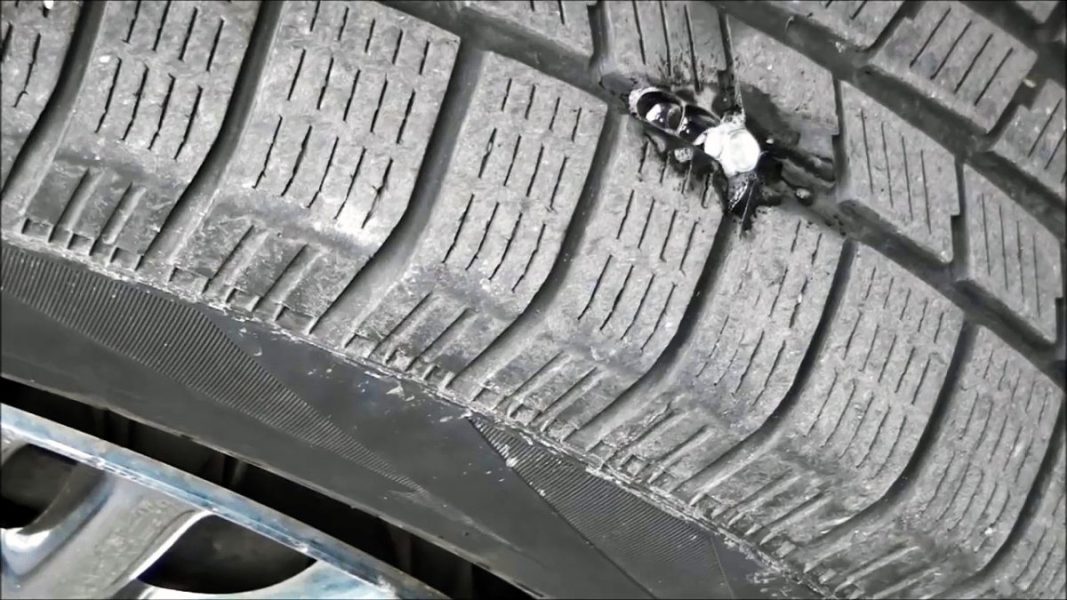
Puncture repair: methods and prices
Content
Pulsed motorcycle tire: what solutions?
How to repair a tire punctured by a nail or screw
And voila, you have a huge nail in your tire, a screw, a blunt tool! What to do?
The first thing to do is not to unscrew the nail or screw. It plugs the hole and if you remove it your tire will quickly deflate. If the nail comes out and you have nothing but an inflatable device, you can even use a wooden screw to prevent air from escaping to the next gas station. Yes, there should always be several different sized wood screws in the toolbox for this type of housing.
Several solutions are available to you depending on the type of puncture and if you have not ridden a flat tire:
- piercing bomb
- ankle repair kit
- professional
Indeed, if you were driving smoothly, the rim could shave off the tire from the inside and damage the tire structure, deforming it; it is not necessarily visible from the outside.
In addition, repairs are carried out only when the hole is on the tread, but not on the sides and, of course, if it is not a gap.
Puncture Bomb: Worst Solution
A puncture bomb is fairly reserved for tires with an inner tube. For a tubeless tire, an ankle repair kit is preferred (and also takes up less space under the saddle).
The principle of the bomb is simple, liquid is pumped into the tire, plugs the hole and solidifies. Attention! This is not a repair, but an impromptu, temporary solution designed only for you to reach the nearest garage, which will definitely require you to change tires afterwards and which will never allow you to consider several thousand kilometers afterwards.
In practice, you:
- start by removing the nail,
- turn the wheel so that the hole goes down,
- place the bomb on the valve and support the bomb: the product passes through the tire, exits through the hole, sticks the tire rubber and dries in the air
- drive a few kilometers at a reduced speed so that the product is distributed inside the tire
- then check your tire pressure regularly
Pay attention to the heat and where you place the bomb. Because the heat can cause the bomb to leak and the product becomes very difficult to remove once it flows all over the place.
Likewise, the bomb product can seep out of the tire through the hole and smudge the rim and wheel ... and you will cry to clean it all up, especially after everything has hardened. As you can imagine, the bomb is the worst possible solution.
Ankle / wick repair kit
The kit is the most efficient solution for flat tire repair. This is a kit that sells for about 28 Euros, including a few dowels or wicks, a glue tube, a useer, a guide tool, and one or more compressed CO2 cylinders (possibly a small portable compressor).
- In practice, you:
- find the hole and mark the location of the puncture (e.g. chalk),
- remove the nail,
- use a usidril, also called an inciser, to homogenize the hole and allow the ankle to insert into it
- take the peg you are covering with glue, if not already pre-coated,
- insert the ankle into the hole with a guiding tool, which, like the cat-needle, allows you to push the ankle folded in half
- inflate the tire with a CO2 cylinder (about 800 g); there are also very small compressors
- cut off the outer end of the ankle
All of these repairs require pressure control at the first filling station you encounter, in addition to the manufacturer's recommendations (usually above 2 bar or even 2,5 bar).
Attention! It is much more dangerous to ride with a flat front tire than with a rear tire.
All professionals and manufacturers will tell you that this is a temporary repair. A temporary renovation that depends on the opening will allow you to end your vacation in peace. For my part, I did this repair on a motorcycle on an almost new lift and essentially while urban with my motorcycle I wanted to see if the tire pressure drops more than usual and the time the repair could take a long time. Thus, I drove several months and several thousand kilometers without worry, alone and in a duet, but while driving "cool". However, I would not risk driving on the highway or stressing the tire with this type of repair. And vice versa, depending on the type of nail, the angle of inclination and the method of performing the repair, some bikers failed to carry out this type of repair for more than fifty kilometers, even redoing it after the fact, which led to the mandatory replacement of tires.
The problem with the wick is that even if a repair is being done, the wick can be quickly removed in one go. And since the hole is then larger, the tire will deflate very quickly and before we have time to say fu ... which will cause it to collapse as soon as we move around the rim. In other words, the fuse is not better to disappear when driving on the highway, because it poses a real danger.
In any case, it is advisable to either change tires or carry out this repair professionally. But since it is necessary when laying out the wick, widening the hole, it greatly reduces the possibility of an effective repair, like a mushroom afterwards.
The ankle repair kit does not take up space and can easily be placed under the saddle, unlike a puncture bomb. It's really easy to do it yourself and is the best workaround.
Professional: repair with mushroom
Mushroom repair is the only real repair that can ensure the maximum durability of your tire.
Some pros just apply the external ankle system to you, simple and quick. Real professionals disassemble the tire, manipulate the inside of the tire (which can be destroyed by fast rolling at low pressure) to fix the part inside, called a mushroom, that sticks to cold vulcanization. The repair is all the more efficient and stable, since the hole is on the tread. On the sides, the curvature of the tire makes it difficult (but not impossible) to retain the fungus over time. The advantage of the mushroom is whether the repair is done or not, but we know this quickly. And if it holds, it lasts a long time (unlike a wick that can be removed right away). Attention, if a tire has been repaired with a wick, a mushroom repair in the same place will work almost half as often.
Then the price of the intervention ranges from 22 to more than 40 euros in Paris and the Paris region and ... about ten euros in the provinces. In short, it's better to live in the provinces! Pay attention to the term used. Some pros are actually happy with putting the wick on the outside faster than a mushroom. Therefore, check the repair technique used before repairing.
This is a repair from the inside, which is, of course, the safest and most durable. This means you will be able to ride for the rest of your tire's life.
I punctured through 3000 km and thus repaired the tire from the inside. The repair continued until the end of my tire's service life of… 33 km! No, no extra scratch, it was the original Bridgestone BT000, real soap in the rain, but super durable! I haven't been able to make the tire live for so long.
Attention to panist messages
The speech is known for many stations that scare you, encouraging you to change tires at the slightest puncture with the risk it poses, and highlighting the danger that others, and especially family, pose. This may be true in some cases, especially if the tire structure has been compromised, whether by a tear or puncture in the sidewall, but very rarely in the event of a tread puncture: the most common. So no, there is no systematic need to change a tire in the event of a puncture, unless it ends up with a wear indicator already reached.
But the price may prompt you to change tires.
Because the repair of each mushroom will cost between 30 and 40 euros. And if it doesn't hold, you still have to replace the tire to which the build price has to be added (about twenty euros in total).
